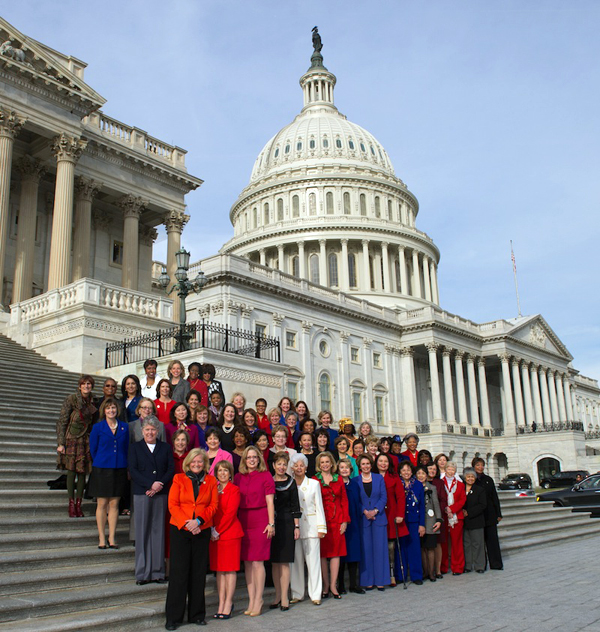The 2014 November elections brought a record number of women to the United States Congress. For the first time in American history, there are more than 100 female lawmakers in the national legislature, with 20 female senators and 84 representatives. Only 20 years earlier, these numbers were half what they are today. In the 1995, there were 57 female lawmakers in Congress total; a mere 11 percent of the total seats available.
While women now almost account for one out of every five lawmakers in Congress, a tremendous improvement since the 1990s, the shift to a Republican controlled Senate during the November elections has also costed women many of their previously held leadership positions, further preventing them from equally exerting power.
The previous year, female congressmen led a record number nine committees in the Senate. Now after the most recent elections, only two of the 20 senate committees are headed by women. In the House, only one committee is headed by a female lawmaker; Candice Miller leads House Administration.
This loss of power for women in Congress is largely due to the tradition of distributing power in Congress according to seniority, and the fact that a larger amount of female lawmakers happen to be Democrats. Since two-thirds of females in Congress are Democrats, unsurprisingly, a larger proportion of senior female lawmakers happen to be Democrats as well. When Republicans took control of the Senate this November, and thus control of the committee chair positions, fewer committee leaders became women. As a committee chairperson, lawmakers have incredible influence in shaping which bills will be debated on the House and Senate floors; it is the committee chair alone that can schedule hearings, one of the important steps for a bill to become a law. As woman lost committee chair positions in Congress, they lost power in influencing the laws passed by Congress as well.
“It doesn’t help us as a party,” Republican Senator Lisa Murkowski said, “when the public out there thinks that there’s this Republican initiative that is not supportive of women, and then they look at the makeup of the Senate and we just don’t have very many.”
This loss of female leadership in Congress is a blow to the efforts to lessen the extreme gender inequality in the United States government. The United State is 98th in the world in terms of equal gender representation in their legislatures. While making up a majority of the population, still over 4 out of 5 elected officials in the United States are men. Men constitute 44 of the country’s current governors, as well as the mayors of 92 of the country’s largest 100 cities.
“There cannot be true democracy unless women’s voices are heard,” Hillary Clinton famously said at the Women in Democracy conference in 1997, “There cannot be true democracy unless all citizens are able to participate full in the lives of their country”.
While Clinton argued for greater gender representation in politics now almost 20 years ago, the United States has actually worsened in relation to other countries in regards to gender representation in government, dropping 45 places in the world’s ranking since 1997. Now, the United States sits three places above the United Arab Emirates, a country where it is still legal to stone women to death.
How come does the United States has such a poor track record with women in politics? Part of the reason, Robin Marty writes for Politico, is the political climate in the United States. The Center for American Women in Politics has found evidence that not only are women much less likely to run for elected office in the United States, but they also are less confident they would win. Further, in a study conducted by Johanna Dunaway of Louisiana State University reviewing over 9,000 newspaper articles concerning gubernatorial and senate races across America, researchers found that female candidates were almost ten times more likely than male candidates to receive news coverage focusing on their personality traits.
“Look, I’ve had $100 million spent mischaracterizing who I am,” said previous Speaker of the House Nancy Pelosi, “Women see that and they say, ‘I could never take that. I would never subject my family to any mischaracterizations about me’”
Female politicians like Pelosi and Clinton whom advocate for greater female representation in politics argue that it is an issue inherent to governmental legitimacy: only by having elected officials whom are representative of the populace will the people’s needs ever be fairly represented. In terms of making ground on this issue, it seems as if the United States still has far to go.
Still, when an abortion bill was introduced into Congress this January attempting to ban all abortions after 20 weeks of pregnancy, female lawmakers displayed the power they can collectively exert, even as an overwhelming minority, by crossing party lines to force the bill to be dropped.
“We have a responsibility,” said Republican Representative Jackie Walorski, “to protect the most vulnerable among us and ensure that women facing unwanted pregnancies do not face judgment or condemnation”. Congresswoman Walorski has a 100 percent approval rating from The National Right to Life Committee; one of the many female lawmakers who does who rallied against the bill.



